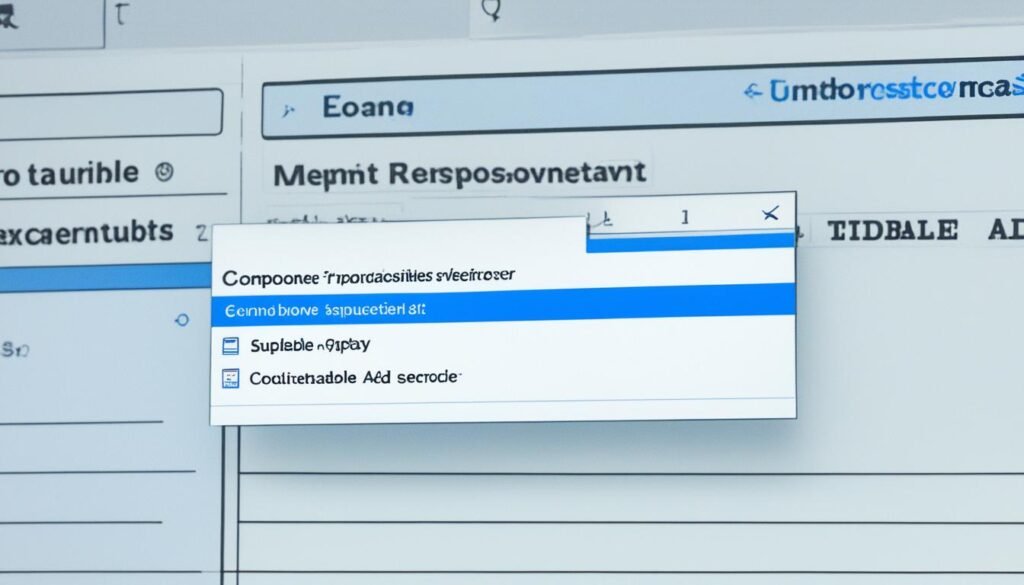How Does Google Ads Generate Responsive Search Ads: Google Ads is a powerful advertising platform that leverages machine learning algorithms to generate responsive search ads. With this innovative approach, advertisers can create ads that dynamically adapt to show more relevant text to potential customers. By utilizing machine learning and constantly testing different combinations of headlines and descriptions, Google Ads ensures that the ads displayed deliver optimal results for each advertising campaign.
Key Takeaways:
- Google Ads uses machine learning to generate responsive search ads.
- Advertisers can enter multiple headlines and descriptions to create adaptable ads.
- The algorithm analyzes user search queries to find the best-performing combinations.
- Responsive search ads reach more potential customers and optimize ad performance.
- Machine learning ensures that ads served are relevant and engaging.
What are Responsive Search Ads?
Responsive search ads are digital advertising formats that appear in Google Search results. As advertisers strive to create highly effective ad campaigns, responsive search ads offer a dynamic and adaptable solution. Unlike traditional ads with fixed ad copy, responsive search ads allow advertisers to mix and match headlines and descriptions to create more relevant and engaging ad content.
With responsive search ads, advertisers can leverage Google’s machine learning algorithms to optimize ad performance and drive better results. These algorithms analyze the user’s search query and dynamically test different combinations of headlines and descriptions to find the most relevant ones for each individual query. This ensures that the ad copy shown to potential customers aligns with their specific search intent, increasing the likelihood of clicks and conversions.
By utilizing the flexible nature of responsive search ads, advertisers can tailor their ad content to match the preferences and needs of their target audience. They can provide multiple headlines and descriptions, allowing the machine learning algorithms to generate various combinations and automatically test and refine the ad copy for better performance.
Using responsive search ads in digital advertising campaigns on Google Search results unlocks the potential to reach a broader audience and deliver more impactful messages. Advertisers can harness the power of ad copy that adapts and evolves based on user behavior, search patterns, and real-time insights. This creates an opportunity to continuously optimize and refine ad content to maximize campaign effectiveness and achieve the desired marketing objectives.
With the ability to dynamically tailor ad copy to each individual’s search query, responsive search ads offer a flexible and powerful tool within the realm of digital advertising. By leveraging Google’s machine learning algorithms, advertisers can optimize their ad performance and enhance the overall effectiveness of their marketing efforts.
How Does Google Ads Generate Responsive Search Ads?
Google Ads utilizes powerful machine learning algorithms to generate responsive search ads that deliver optimal ad performance. When creating a responsive search ad, advertisers have the flexibility to input multiple headlines and descriptions. The algorithm then analyzes the user’s search query and automatically tests various combinations of headlines and descriptions to determine the most effective ad combinations. Through continuous optimization, Google Ads ensures that the ads displayed to users are both relevant and engaging.
By leveraging machine learning, Google Ads constantly learns from user interactions and refines the ad content to improve the overall performance. This automated approach streamlines the ad creation process and maximizes the impact of each ad. Advertisers can trust that their responsive search ads are backed by advanced algorithms that constantly adapt to user preferences and search trends.
This seamless integration of technology allows advertisers to focus on crafting compelling content while Google Ads takes care of finding the most effective combinations. With machine learning algorithms at the core, Google Ads ensures that advertisers can reach their target audience with tailored ads that yield impressive results.
Benefits of Responsive Search Ads
Responsive search ads offer several benefits for advertisers. They provide a powerful tool to reach potential customers and create more effective PPC campaigns. By uploading multiple headlines and descriptions, advertisers can leverage Google’s machine learning algorithms to optimize ad performance and deliver the most relevant messages to customers, increasing the chances of attracting their attention and driving engagement.
One of the key advantages of responsive search ads is their ability to reach a wider audience. By having multiple headline and description options, advertisers can create ad variations that resonate with different segments of their target market. This enables them to effectively communicate their value proposition and capture the interest of a diverse range of potential customers.
Furthermore, responsive search ads allow advertisers to continuously optimize their campaigns based on real-time data and insights. Google’s machine learning algorithms constantly test different combinations of headlines and descriptions to identify the best-performing ad variations. This data-driven approach helps advertisers enhance their ad performance and achieve higher click-through rates, ultimately maximizing the return on their PPC investment.
Another benefit of responsive search ads is their flexibility in adapting to different search queries. Since Google Ads automatically combines different headlines and descriptions, responsive search ads can dynamically match the user’s search intent and deliver highly relevant ad copy. This not only improves the overall user experience but also increases the likelihood of attracting potential customers and driving conversions.
Ultimately, responsive search ads provide advertisers with a powerful tool to reach potential customers, create effective PPC campaigns, and optimize ad performance. By leveraging Google’s machine learning algorithms and the flexibility of responsive search ads, advertisers can enhance their advertising strategy and achieve better results in today’s competitive digital landscape.
Understanding Machine Learning Algorithms by Google

Google Ads utilizes powerful machine learning algorithms to analyze data from past search queries and deliver highly relevant ads to users. By harnessing the capabilities of machine learning, Google Ads is able to serve ads that are specifically tailored to match the user’s search query, increasing the likelihood of engagement and conversions.
The machine learning algorithms employed by Google Ads go beyond simply analyzing individual search queries. They also take into account the performance of different combinations of headlines and descriptions to identify the most effective ad variations. By testing and optimizing these combinations, Google Ads ensures that its users are presented with the most compelling and relevant ads for their specific search.
With machine learning algorithms, Google Ads constantly refines its ad delivery process, ensuring that the ads shown to users are not only contextually relevant but also highly engaging. By analyzing vast amounts of data and making data-driven decisions, Google Ads ensures that advertisers can maximize their ad performance and drive meaningful results.
Through the power of machine learning, Google Ads has revolutionized the way in which ads are served to users, allowing businesses to reach their target audience with optimized and highly relevant advertisements.
To demonstrate the significance of machine learning algorithms in the context of Google Ads, consider the following example:
“Machine learning algorithms analyze user search queries and ad performance to find the most effective combinations of headlines and descriptions.”
| Benefits of Machine Learning Algorithms in Google Ads |
|---|
| Optimizes ad delivery for relevance and engagement |
| Maximizes ad performance through data-driven decisions |
| Delivers contextually relevant ads to users |
| Improves targeting capabilities for advertisers |
Maximizing Ad Performance through Data-Driven Decisions
One of the key advantages of using machine learning algorithms in Google Ads is the ability to make data-driven decisions that optimize ad performance. By analyzing the performance of different combinations of headlines and descriptions, Google Ads can identify the variations that yield the highest click-through rates and conversions.
Through continuous testing and optimization, Google Ads ensures that advertisers can effectively target their audience and achieve maximum ROI for their advertising campaigns.
How Does Adsbot Help You Optimize Your Ads?

Adsbot is an ads assistant that provides valuable support in optimizing your ads, improving campaign results, and enhancing overall ad performance. Leveraging advanced optimization techniques and automation, Adsbot allows you to focus on your advertising strategy while maximizing the effectiveness of your ads.
With Adsbot, you gain access to a range of powerful features designed to streamline your ad optimization process:
- Custom Reports: Adsbot generates custom reports that provide in-depth insights into the performance of your ads. These reports help you identify strengths and weaknesses, enabling you to make data-driven decisions and refine your advertising strategy.
- Performance Tracking: Adsbot closely monitors the performance of your ads, tracking key metrics such as click-through rates, conversions, and engagement. This real-time tracking allows you to stay informed of campaign progress and make necessary adjustments to optimize results.
- Ad Variation Analysis: Adsbot conducts thorough analysis of different ad variations, comparing their performance to identify the most effective combinations. By understanding which variations yield the best results, you can make informed decisions and continuously improve your ad campaigns.
By utilizing Adsbot’s capabilities, you can optimize your ad performance, increase campaign efficiency, and achieve better results. Let Adsbot be your trusted partner in enhancing your advertising efforts and maximizing the impact of your campaigns.
Testimonial:
“Adsbot has been a game-changer for our ad campaigns. By automating optimization processes and providing valuable insights, it has helped us achieve significant improvements in our ad performance and campaign results. We highly recommend Adsbot to any advertiser looking to enhance their advertising efforts.”
– Mark Johnson, Marketing Manager at ABC Company
Ready to take your ads to the next level? Try using Adsbot today and unlock its powerful optimization capabilities for your advertising campaigns.
Create a Responsive Search Ad

To create a responsive search ad, advertisers need to go to their Google Ads account and access the Ads section. From there, they can click the plus button and select “Responsive search ad.”
Advertisers should enter the final URL, display path text, and provide a minimum of 3 headlines and 2 descriptions. These headlines and descriptions should be carefully crafted to attract the attention of potential customers and communicate the key message of the ad.
Google Ads will then automatically test different combinations of the provided headlines and descriptions. This testing is done using machine learning algorithms to determine which combinations perform best in terms of ad performance. It’s important to note that providing more than the minimum number of headlines and descriptions allows for a wider range of combinations to be tested and optimized over time.
Creating a responsive search ad gives advertisers the opportunity to effectively reach their target audience and achieve the desired results. By leveraging the power of Google Ads’ machine learning algorithms, advertisers can optimize their ad performance and increase the chances of attracting clicks and conversions.
Edit a Responsive Search Ad

To edit a responsive search ad, advertisers can go to their Google Ads account and access the Ads section. By hovering over the ad they wish to edit, they can click the edit icon and make the desired changes to the ad’s URL, final URL, headlines, descriptions, or URL options. It’s important to note that removing or editing headlines or descriptions can impact the ads’ performance.
| Action | Steps |
|---|---|
| 1 | Log in to your Google Ads account. |
| 2 | Navigate to the “Ads” section. |
| 3 | Hover over the responsive search ad you want to edit. |
| 4 | Click on the edit icon that appears. |
| 5 | Make the desired changes to the ad’s URL, final URL, headlines, descriptions, or URL options. |
| 6 | Click “Apply” or “Save” to save the changes. |
When editing a responsive search ad, it’s essential to consider the impact of deleting or modifying headlines and descriptions. These elements play a crucial role in the ad’s performance and how it resonates with potential customers. Advertisers should carefully review the changes before applying them to ensure the ad continues to deliver optimal results.
Pin Headlines and Descriptions to Specific Positions
Advertisers have the option to pin headlines and descriptions to specific positions in their responsive search ads. This feature allows advertisers to have greater control over the placement of individual headlines and descriptions within the ad. By pinning text to specific positions, advertisers can ensure that crucial messages are always shown prominently to potential customers.
Pinning headlines and descriptions to specific positions can be particularly beneficial when advertisers want to emphasize certain aspects of their products or services. For example, a clothing retailer can pin a headline about a limited-time sale or a special discount to the first position to catch the attention of potential customers. By strategically placing key messages, advertisers can optimize their ad performance and increase the likelihood of attracting clicks and conversions.
However, it’s important to consider the impact on ad performance when pinning headlines and descriptions. Pinning reduces the overall number of combinations that can be tested, which means there may be fewer opportunities to find the most effective ad variations. Advertisers should carefully analyze their campaign goals and audience preferences before deciding to pin text to specific positions.
Pin headlines and descriptions to specific positions in responsive search ads to ensure that important messages are always visible and attract potential customers. However, weigh the benefits of control against the potential impact on ad performance.
By leveraging the flexibility of responsive search ads and utilizing the pinning feature wisely, advertisers can optimize their ad performance and drive better results. It’s essential to regularly monitor and analyze the performance of pinned headlines and descriptions to ensure that they align with the campaign goals and resonate with the target audience.
Next, let’s explore how pinning headlines and descriptions can be implemented in Google Ads and how advertisers can make the most of this feature to enhance their ad campaigns.
Also Read: Efficient Network Traffic Monitoring Solutions
Conclusion
Responsive search ads are a powerful tool within the Google Ads platform that harnesses the capabilities of machine learning algorithms to optimize ad performance. Advertisers can create flexible ads by inputting multiple headlines and descriptions, allowing the ads to adapt and display more relevant messages to potential customers.
Through constant testing and optimization, Google Ads ensures that responsive search ads are engaging and effective in driving clicks and conversions. By leveraging machine learning, advertisers can maximize the impact of their advertising campaigns and achieve better results.
With responsive search ads, businesses can reach a wider audience and create more effective pay-per-click (PPC) campaigns. By utilizing Google Ads’ machine learning algorithms, advertisers can optimize their ads for better performance and higher click-through rates. This optimization process analyzes user search queries and automatically tests different combinations of headlines and descriptions to determine the best-performing ad content.
By investing in responsive search ads and harnessing the power of Google Ads and machine learning, advertisers can unlock the potential to deliver highly relevant and engaging ads that drive meaningful interactions with their target audience.
FAQs
Q: How does Google Ads generate Responsive Search Ads?
A: Google Ads creates Responsive Search Ads by automatically generating multiple ad combinations using 15 headlines and 4 descriptions. It then mixes and matches these headlines and descriptions to create ads that are relevant to the search terms entered by users.
Q: What is the difference between Responsive Search Ads and Expanded Text Ads?
A: The main difference between Responsive Search Ads and Expanded Text Ads is that RSAs allow for more flexibility in ad format and content. RSAs can have up to 15 headlines and 4 descriptions, while Expanded Text Ads only have 3 headlines and 2 descriptions.
Q: How do Responsive Search Ads work in Google Ads?
A: Responsive Search Ads work by allowing advertisers to input multiple headlines and descriptions for each ad. Google Ads then dynamically generates different ad combinations to match the search terms entered by users, making the ads more relevant and engaging.
Q: What are the pros of using Responsive Search Ads?
A: Some pros of using Responsive Search Ads include the ability to show more relevant ads to users based on their search terms, higher ad strength due to multiple ad variations, and the convenience of Google automatically generating ad combinations for optimal performance.
Q: Can Responsive Search Ads help in improving search campaigns?
A: Yes, Responsive Search Ads can help improve search campaigns by increasing ad relevance, reaching a wider audience with different ad combinations, and allowing for more dynamic and personalized ad content based on search terms.
Q: How to switch from Expanded Text Ads to Responsive Search Ads?
A: To switch from Expanded Text Ads to Responsive Search Ads, you can create a new ad group or edit existing ad groups to include Responsive Search Ads. Simply follow the steps provided by Google Ads on creating and setting up RSAs in your campaigns.
Q: Are there any cons of using Responsive Search Ads?
A: One potential con of using Responsive Search Ads is that advertisers have less control over the specific headline and description combinations that are displayed. However, the benefits of increased ad relevance and performance often outweigh this limitation.
.
Source Links
- https://adsbot.co/how-does-google-ads-generate-responsive-search-ads/
- https://school4seo.com/google-ads-search-advertising-exam/how-does-google-ads-generate-responsive-search-ads/
- https://support.google.com/google-ads/answer/7684791?hl=en





